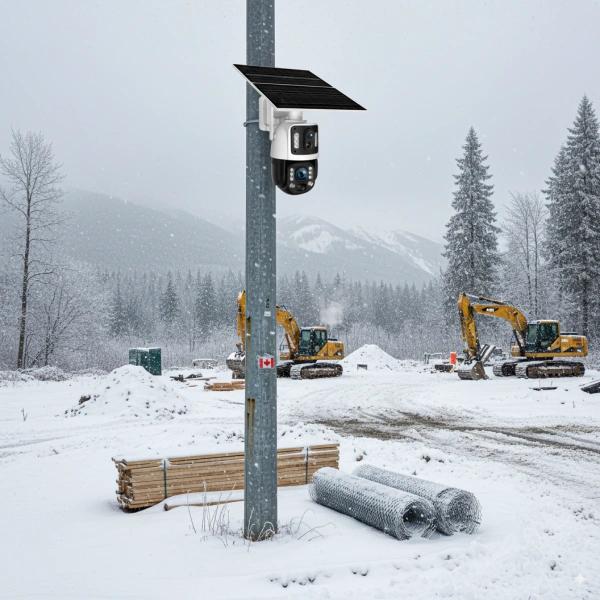Reservoir Security Monitoring: How Solar Cameras Tackle Harsh Environments and Ensure Water Resource Safety
Ensuring the security of water reservoirs and dams is a critical, non-negotiable task for municipal and governmental bodies. These vast, often remote sites are vulnerable to unauthorized access, vandalism, and illegal dumping. However, implementing effective surveillance is plagued by a fundamental challenge: the complete lack of power and network infrastructure. The cost of trenching cables for electricity and data across miles of rugged terrain is often prohibitively expensive, leaving these vital assets dangerously exposed.
Traditional security solutions were simply not designed for such off-grid environments. They fail to address the core operational realities of reservoir management. This is where modern, self-sufficient technology provides a definitive answer. 4G solar security cameras have emerged as the premier solution, offering a robust, cost-effective, and rapidly deployable method to establish a vigilant eye over our most critical water resources, no matter how isolated the location.
As an engineering-driven factory, we understand that reliability in these scenarios is not a feature—it’s the entire mission. A camera that fails due to a few cloudy days or a humid morning is not a security tool; it’s a liability. True reliability is born from thoughtful design, from the battery chemistry to the data transmission protocol.
The Engineering Behind Off-Grid Reliability
A solar-powered security camera is more than just a camera with a solar panel attached. It is an integrated ecosystem designed for energy autonomy and resilience. For demanding applications like reservoir monitoring, three core components are paramount: the power system, the connectivity module, and the physical enclosure.
Advanced Power Management (BMS): The heart of a solar camera’s longevity is its battery and the intelligence that manages it. We leverage high-capacity lithium-ion batteries coupled with a sophisticated Battery Management System (BMS). This isn’t just about charging and discharging; a robust BMS provides crucial protections against overcharging, deep discharging, and extreme temperatures, ensuring the battery operates safely and delivers a long service life even in fluctuating weather conditions.
Uninterrupted 4G LTE Connectivity: Wi-Fi is a non-starter in remote areas. Our cameras are equipped with industrial-grade 4G LTE modules that provide a stable, secure connection for transmitting live video and alerts. This allows security personnel to monitor sites in real-time from a central control room, receive instant notifications of detected motion, and remotely control PTZ (Pan-Tilt-Zoom) functions to investigate incidents without deploying personnel. The choice between 4G and Wi-Fi is a critical decision point determined by the deployment environment.
Built for Harsh Environments: A reservoir is an unforgiving environment with high humidity, rain, dust, and temperature swings. Our cameras are engineered with IP66 or higher weatherproofing ratings, ensuring they are sealed against dust ingress and powerful water jets. The housing materials are selected for corrosion resistance and durability, guaranteeing operational integrity year after year.
Solar 4G Cameras vs. Traditional Wired Systems: A Cost-Benefit Analysis
For project managers and procurement specialists, the decision often comes down to Total Cost of Ownership (TCO) and operational feasibility. A direct comparison reveals the overwhelming advantages of a solar-powered approach for remote infrastructure.
| Feature | Solar 4G Security Camera | Traditional Wired Security System |
|---|---|---|
| Power Source | Self-sufficient via solar panel and integrated battery. | Requires connection to the power grid; involves extensive and costly trenching. |
| Connectivity | Wireless via 4G LTE cellular network. | Requires physical data cables (fiber optic or ethernet), adding to installation complexity and cost. |
| Installation Cost & Time | Low. Can be mounted on existing poles or structures in hours. Minimal labor required. | Extremely high. Involves civil engineering work, permits, labor, and weeks or months of deployment time. |
| Maintenance | Minimal. Primarily involves occasional cleaning of the solar panel. | Higher. Risk of cable damage from environmental factors or animals requires regular inspection and repair. |
| Scalability | Excellent. New cameras can be added to the system easily without disrupting existing infrastructure. | Poor. Expanding the system requires additional, expensive cable runs. |
Case Study: Securing the Pine Ridge Reservoir
- Problem: The Pine Ridge Reservoir, a key water source for a downstream community, faced persistent issues with unauthorized night-time fishing and illegal waste dumping. The remote location made it impossible to install a traditional CCTV system, and bi-weekly security patrols were costly and largely ineffective, often arriving after an incident had occurred.
- Solution: In partnership with a local systems integrator, we designed a solution using ten of our S10-4G solar PTZ cameras. These units were strategically placed to cover all access roads, shorelines, and the dam spillway. The entire system was deployed by a two-person team in just three days with no heavy machinery.
- Result: Within the first six months, the system achieved a 95% reduction in reported unauthorized activities. Real-time alerts enabled law enforcement to apprehend trespassers on two separate occasions. The water authority reduced its physical patrol budget by 70%, reallocating funds to other critical maintenance. Furthermore, the cameras provided valuable operational data, allowing engineers to remotely monitor water levels and spillway conditions, improving response times during storm events.
Troubleshooting Common Concerns for Remote Deployments
As engineers, we anticipate the questions that arise from real-world field conditions. Here are solutions to common challenges in reservoir monitoring.
Q1: What happens if there are several days of heavy clouds or rain?
This is a critical power-budgeting question. Our systems are engineered with oversized solar panels and high-capacity batteries calculated based on the location’s average solar irradiance. For a typical deployment, the battery holds enough charge to power the camera for 3-5 days of continuous operation with zero sunlight, ensuring uninterrupted surveillance through extended periods of inclement weather.
Q2: How much cellular data will these cameras use?
Constant streaming is inefficient and expensive. Our cameras operate in a low-power standby mode, only activating and recording when the onboard AI detects a relevant event, such as a person or vehicle. This event-based approach, combined with efficient H.265 video compression, dramatically reduces data consumption, making a standard M2M/IoT data plan highly affordable.
Q3: How resistant are the cameras to vandalism or theft?
Our cameras are built with durable metal housings and use secure, tamper-resistant mounting hardware. They are typically installed at a height that makes them difficult to reach without a ladder. Additionally, some models feature built-in G-sensors that can trigger an immediate alert to the control center if the camera is struck or moved, ensuring a rapid response to any tampering attempts.
Checklist: Selecting the Right Solar Camera for Water Resource Security
When sourcing a solution for critical infrastructure like reservoirs, not all solar cameras are created equal. Use this checklist to ensure you are specifying a truly reliable system:
- ✅ IP66 or IP67 Rating: Essential for protection against rain, humidity, and dust.
- ✅ Appropriate Battery & Panel Sizing: Demand a power calculation from your supplier based on your specific geographic location and desired operational uptime.
- ✅ 4G LTE Band Compatibility: Confirm the camera’s 4G module supports the frequency bands used by cellular carriers in the deployment region.
- ✅ High-Performance Night Vision: For 24/7 security, choose between powerful infrared (IR) for discreet surveillance or Starlight/full-color technology for detailed color images in low light.
- ✅ PTZ Functionality: A single PTZ camera can cover a wide area that would otherwise require multiple fixed cameras, reducing costs and points of failure.
- ✅ AI-Powered Detection: Specify cameras with onboard AI to accurately differentiate between humans, vehicles, and false alarms from animals or weather, ensuring your security team only responds to credible threats.
The security of our water infrastructure is too important to be compromised by logistical hurdles. Solar-powered 4G security cameras provide a technologically advanced, financially viable, and operationally superior solution for monitoring remote reservoirs and dams. If you are a 4G operator, brand, or engineering contractor looking to provide robust security solutions for critical infrastructure, we can help. Partner with UBOXCAM to leverage our 13 years of design and manufacturing experience. Contact us today to discuss your project requirements and let us engineer a customized surveillance solution that delivers uncompromising reliability, wherever it’s needed.

